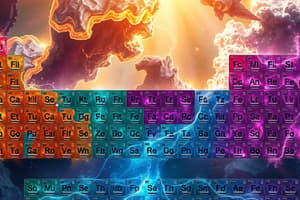Podcast
Questions and Answers
Which statement correctly describes noble gases?
Which statement correctly describes noble gases?
- They are primarily found in liquid form at room temperature.
- They have a full valence shell and exhibit low reactivity. (correct)
- They are highly reactive and unstable.
- They are excellent conductors of electricity.
What is the primary characteristic that distinguishes metals from non-metals?
What is the primary characteristic that distinguishes metals from non-metals?
- Non-metals can conduct electricity better than metals.
- Metals are always solid at room temperature.
- Non-metals are less chemically reactive than metals.
- Metals are ductile and conduct electricity well. (correct)
What occurs during the neutralization reaction between an acid and a base?
What occurs during the neutralization reaction between an acid and a base?
- Liquid hydrogen is formed.
- A gas is produced.
- The solution becomes a solid precipitate.
- Salt and water are produced. (correct)
How does the pH scale range indicate acidity and alkalinity?
How does the pH scale range indicate acidity and alkalinity?
Which of the following correctly describes metalloids?
Which of the following correctly describes metalloids?
What is the role of acid-base indicators?
What is the role of acid-base indicators?
In a displacement reaction, which condition must be met?
In a displacement reaction, which condition must be met?
Which of the following is a common characteristic of non-metals?
Which of the following is a common characteristic of non-metals?
Flashcards
Periodic Table Groups
Periodic Table Groups
Vertical columns in the periodic table; elements in the same group share similar chemical properties due to having the same number of valence electrons.
Metals
Metals
Elements that are typically lustrous, good conductors of heat and electricity, malleable, and ductile, like iron and copper.
Non-Metals
Non-Metals
Elements that are usually dull, poor conductors of heat and electricity, and brittle, like carbon and sulfur.
Acids
Acids
Signup and view all the flashcards
Alkalis (Bases)
Alkalis (Bases)
Signup and view all the flashcards
Neutralization
Neutralization
Signup and view all the flashcards
pH Scale
pH Scale
Signup and view all the flashcards
Indicator
Indicator
Signup and view all the flashcards
Study Notes
Periodic Table Structure and Element Classification
- Periods: Horizontal rows on the periodic table, indicating the number of electron shells an element has.
- Groups: Vertical columns on the periodic table, where elements share similar chemical properties due to the same number of valence electrons.
- Metals: Lustrous, conductive, malleable, and ductile elements (e.g., Iron, Copper).
- Non-Metals: Dull, poor conductors, and brittle elements (e.g., Carbon, Sulfur).
- Noble Gases: Inert elements with full valence electron shells, and low reactivity (e.g., Helium, Neon).
- Element Arrangement: Elements are arranged in increasing order of atomic number.
- Element Categories: Elements categorized into Metals, Non-Metals, and Metalloids.
- Key Trends: Atomic size, ionization energy, and electronegativity are key trends across the periodic table.
Acids, Alkalis, and Balancing Chemical Equations
- Acids: Substances with a pH less than 7, sour taste, and turn blue litmus paper red. Examples include HCl and H₂SO₄.
- Alkalis (Bases): Substances with a pH greater than 7, slippery feel, and turn red litmus paper blue. Examples include NaOH and KOH.
- Neutralization Reaction: Acid + Base → Salt + Water.
- Acid-Base Indicators: Substances which change color to indicate the acidity or alkalinity of a solution. Examples include litmus paper, phenolphthalein, and methyl orange.
- Universal Indicator: Shows pH on a scale.
- Natural Indicators: Extracts from plants (e.g., red cabbage juice).
- Acids' Uses: In industrial production, cleaning agents, and food preservation.
Displacement Reactions
- Displacement Reaction: A more reactive element can displace a less reactive element from its compound.
- Example: Zn + CuSO₄ → ZnSO₄ + Cu.
- Applications: This includes metal extraction, and galvanization.
Upcoming Topics and Experiment Protocols
- Advanced Chemical Reactions: Future topics will extend on chemical reaction concepts.
- pH and Reactivity Experiments: Upcoming classes will include experiments focused on pH measurements and reactivity.
- pH Scale: Ranges from 0 to 14, measuring the concentration of hydrogen ions.
- Experimental Protocols: This includes appropriate use of pH meters, solution preparation, and safety precautions.
Studying That Suits You
Use AI to generate personalized quizzes and flashcards to suit your learning preferences.
Description
Explore the structure of the periodic table, including the classification of elements into metals, non-metals, and noble gases. Additionally, dive into the properties of acids and alkalis, and learn how to balance chemical equations. This quiz covers vital concepts in chemistry, suitable for any chemistry student.




